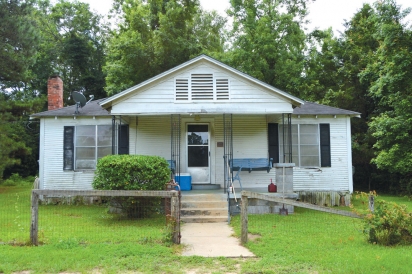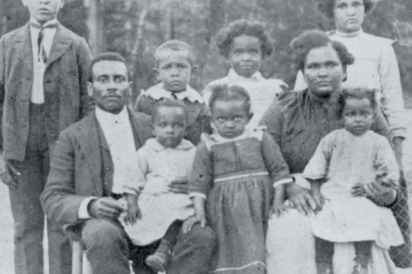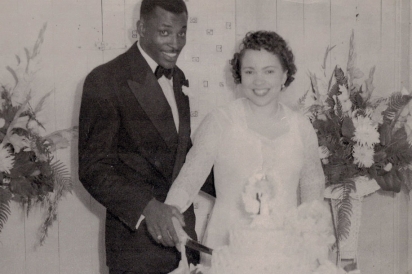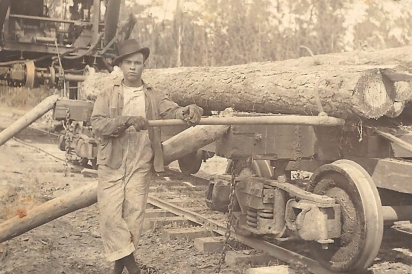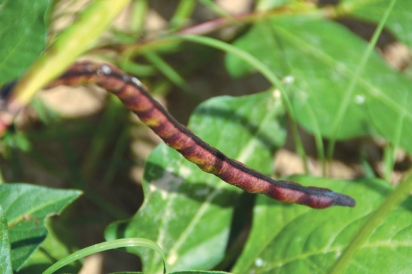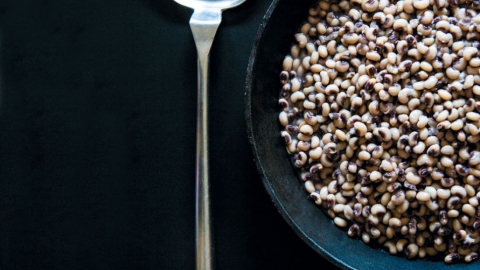Passion for purple hull peas
A tale of community spirit, history and sense of belonging
For the generations connected to this soil, the purple hull pea is so much more than a crop in a field full of history as long as the rows of peas to pick. It’s an ardent cry to recall the people and stories they are all connected to. And with each springtime planting that gives way to shoots spreading deep in the soil, the front porch sits by, its sagging frame dying near a green wood of tall longleaf pine, an homage to what remains of the more than 500 African American Freedom colonies in Texas, parts of rural Texas history undesignated by courthouses or platted streets.
This particular porch—where stories were passed down and peas were hulled for nearly a hundred years—is not like other houses that have come and gone. This is the 1922 homestead of A. T. and Addie Odom, great-grandson of Jim and Winnie Shankle, for whom the community is named. In 2012 this historic white wood-frame home became the focal point of the Texas Purple Hull Pea Festival.
The Shankleville descendants have a passion for their community that runs deep. More than that familiar flavor of summer next to hot cornbread it is the smell of the soil, the sound of creaky wood floors and the sight of a wooded spring. It is home. The pea hasn’t changed, though the community has. The pea sends forth its shoots and pods like clockwork, and 90 days later, a harvest. Like the white wooden church down the road that would ring its bells at the news of trouble or death, the purple hull pea is a symbol to keep the family connected, as rooted to the memories of a place as the last generation was. Only now it takes a passionate community committed to make sure that soil is never forgotten.
HE FOUND HER
In the family’s oral history book, some say Jim Shankle heard the men’s voices talking business from the door, candlelight pouring out into the black night where he stood on a plantation in Mississippi. They say he heard his wife Winnie was being sold, or maybe she was being given as a wedding present to a young couple. The point was, she was bound for Texas without him.
Winnie departed their Mississippi home by wagon the next day with her new owner for towns being plotted along the east Texas border. In the 1840s, the high season was just beginning for cotton planters migrating from Mississippi to Texas in search of fresh soil. It might have taken days or months of thinking it over. No one really knows. But the creation story of Shankleville is bound by that decision: He ran away in search for her.
For Winnie, every sunrise in Texas meant another day to mourn the loss and separation. But then one day, as Winnie looked at her reflection in the spring she’d drawn water from every day for her master, she heard Jim’s voice. He had kept his promise. He had walked over 400 miles and found her.
Right there, shielded under the cool arms of black walnut branches, they made their start. He was allowed to stay and more than two decades later—in 1867—he would be one of the first African Americans in Texas to buy land as a free man. He worked with his son-in-law, Stephen McBride, to achieve land negotiations that established the community of Shankleville, 15 miles north of the county seat of Newton.
SHE SAID SHE’S NOT GONNA LET THAT HAPPEN
Addie Odom still drove her 1965 Ford Fairlane to church until she was 90. She still organized a quilting club, gardened, made lye soap and took the teacakes she was famous for to weddings and the Mt. Hope Sunday School every Valentine’s Day. She’d always said she planned to “wear out, not rust out.” Before she died in 1987, Addie—known by her family as Big Mama—was out for a drive one time down a dirt road with her granddaughter, Lareatha Clay, in the car. The group came upon a relative’s abandoned house where the roof was caving in, and she said: “One day, my house is gonna look like that.” Lareatha promised her she wouldn’t let that happen and 25 years later, she made good on her promise, commissioning a historian to do the research necessary to get the Odom home listed on the National Register of Historic Places, and hiring an architect to prepare a restoration plan.
The 1906 picture of A. T. Odom shows him standing tall at 13, behind his father, Jimmy Odom, oldest son of Harriet, Jim and Winnie Shankle’s oldest daughter, and the Rev. Joseph Odom. In three years A.T. would be the man of the house after losing both parents to early death. A.T. married Addie Lewis in 1915. He loaded logs on the railcars for the Biloxi community and farmed weekends. They built the house of lumber salvaged from the homestead of Harriet and Joseph Odom. They built it near the crepe myrtle trees Harriet had planted and Addie added a sycamore. When Jim and Winnie made their start they had made horse collars by plaiting corn shucks and hickory saplings. A. T. would make his start in carpentry.
A. T. began teaching carpentry in Wiergate for the Wier Long Leaf Lumber Company, the largest west of the Mississippi until it closed in 1942. He became the only African American foreman and carpentry teacher they employed. By the mid 1930s, he’d established his own construction business. The Odoms ran a community store, a barbershop, and milled sugar cane harvests for free among a long list of services they provided the community.
SHE WORE A CRISP COAL-BLACK SHIRT COLLAR DRESS
Larutha, Lareatha’s mother, hunches her shoulders in concentration, her mind sharp focused. A veteran high school English teacher, she still stops to correct her daughter’s grammar. The great-great-great-granddaughter to Jim and Winnie Shankle, Lareatha Clay sits in her mother’s living room in Beaumont with boxes of memories piled around the room. They’re stacked high on the table where her mother’s wheelchair sits. Larutha holds her 1945 freshman college history project in her withering hands. The mother-and-daughter team spans decades of work they’ve built, work that founded the Shankleville Historical Society in 1988. They were recognized in March of 2015 by Preservation Texas, a nonprofit preserving the historic resources of Texas, when the group added the Odom homesite to its list of Texas’ Most Endangered Places. [update: Larutha Clay passed away May 3, 2015]
In 1945, no student’s feet touched the soil of the Prairie View college campus with a better understanding of the cost to be there than Larutha Clay. Unlike many of her classmates, she had paid her way, graduating first from the Madame C. J. Walker’s Beauty School in Dallas with her sister Arzela.
She stands in black leather open-toed heels and a crisp coal-black shirt collar dress, posing for photos with a dozen of her classmates—an older freshman who entered the class at 19, smiling with a working girl’s confidence, and the best hair. In the picture she stands as if she had known all along she wasn’t meant for cutting hair. A quote from the author and playwright Somerset Maughan marks the bottom of the photo with the words: “out of chaos, the artist creates a thing of beauty.” For her it came from a pair of scissors.
She married a track and football boy from Beaumont. She was fiery and opinionated; his classmates marked him in his senior yearbook as reserved and quiet. They spent their lives as teachers at schools in East Texas from Newton to Beaumont to Port Arthur. She was the kind of teacher you could trust because she was never done with her own education. In her 1955 graduate thesis at Prairie View, she wrote on the playwright Eugene O’Neill’s treatment of the Negro character, expressing in her paper the power of story as a means of reflecting inner conflicts through the subconscious mind. She wrote, even though O’Neill “opened the way for the Negro on the serious stage … what white playwrights have presumably still ignored is the portrayal of the Negro as essentially human and normal, filled with the same desires and moved by the same impulses as other men, following the same general pattern of life, subject to the same fate.”
She kept a sense of urgency gathering family and stories back to their roots until her final days in May of 2015.
HE HACKS HIS WAY
The windows look out across a hayfield to the cemetery on the hill about a hundred yards away where 75 freedmen families once called this stretch of land home.
Harold Odom Junior, 73, grandson to A. T. and Addie, hacks his way through the undergrowth despite the heat and mosquito cloud he’s swatting at. It’s in his blood to tell the story. He’s dressed in a canary yellow golf polo, khakis and boots. The August humidity furls back as the cool of the dark wood gives way to the story and he leads the group to the spring where Jim and Winnie first met. He swings an old machete in step through the brush, brows crinkling up into his forehead before each animated emphasis and pause. The swoop and slash of the story stir every word.
He stops to catch his breath, leaning his strong limbs of the tree next to the fallen posts of the barn that was milled by his grandfather, he says, continuing through unforgiving new growth of greenbriar.
“If Big Mama were here, this place’d be swept clean,” he had said awhile back when surveying the chicken yard. Apart from the barn, few late 19th century dwellings still stand. The gristmill, the cotton gin, the syrup mill and three school buildings are all gone. Harold’s generation is the last with deep-rooted memories of spending summers at the house with grandparents. Like a hen looking to gather her chicks, the white walls seem to watch for them as travelers pass her by. Every summer during reunion time, they come back, she says. They always come back.



